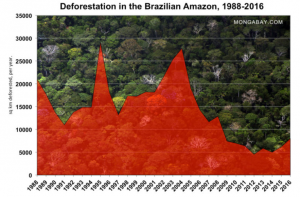The fall of the Mayan civilization has puzzled scholars for years. At the Mayan’s peak, the civilization was made up by more than 19 million people. However, during the 8thor 9thcentury the Mayan civilization suddenly collapsed. In his book “Collapse,” Jared Diamond puts forth a theory about the sudden demise of the Mayan civilization. Diamond believes that a prolonged drought which was intensified by rapid deforestation led to the collapse of the once great Mayan civilization (Stromberg).Studying the collapse of the Mayan civilization can be beneficial for a multitude of reasons. We can determine the ways in which the Mayans exacerbated deforestation along with the effects which it had. In the book, “American Anthropologist,” Fisher and Feinman link past human activity to a range of environmental changes. Analysis of past human activity and its effects on the environmental are critical to evaluating contemporary environmental debates and policies. As seen in Figure 1, the decline of the Mayan population was closely tied to rapid deforestation coupled with the soil erosion. The Mayans burned and chopped down their forests in order to clear land for agriculture and also to acquire wood for the elaborate construction of their cities (Stromberg). Deforestation in Central American still remains extremely problematic today. In Honduras, it is estimated that up to 85% of timber which is cut down is done so illegally (Charlotte). Deforestation is a great threat to biodiversity, leading birds, animals and plants to lose their natural habitats. The world’s forests are one big carbon sink, storing and locking away carbon dioxide avoiding its immediate release into the atmosphere. When a tree dies all of the carbon that has been stored away is released back into the atmosphere. If the tree is cut down prematurely, the process is accelerated. Currently global loss of forests is contributing 12-15% of total greenhouse gas emissions (Charlotte). This information about the fall of the Mayan civilization becomes increasingly alarming when we look into what is currently going on in Brazil. Recently, a new President was elected in Brazil, Jair Bolsonar. Bolsonar’s environmental policies can be perceived as being a threat to human existence all together. As seen in Figure 2, deforestation of the Brazilian Amazon has been on a general downtrend. However, this may soon change. Bolsonar’s policies favor business over biodiversity and calls for pro-market ways of exploiting Brazil’s natural resources. Bolsonar also has promised to weaken the enforcement of environmental laws. It is extremely important to learn from the failures of past human societies and civilizations. It is thought that we have 12 years to prevent the dangerous destabilization of the Earth’s climate (The Guardian). We have seen how deforestation led to the demise of the once great Mayan civilization. Hopefully we will use the information we have learned from the past to solve the deforestation problems which are still extremely prevalent today.
Additional Readings:
www.cropcycle.org/2011/07/25/deforestation-in-central-america/.
Figure 1. Population density, Deforestation and Soil Erosion for the Mayan Civilization
Source: https://ourworldindata.org/forests
Figure 2: Deforestation in Brazil
Source: https://rainforests.mongabay.com/amazon/deforestation_calculations.htm
Works Cited
Charlotte. “Deforestation in Central America.” Crop Cycle, www.cropcycle.org/2011/07/25/deforestation-in-central-america/.
Fisher, Christopher T, and Gary M Feinman. American Anthropologist .
Stromberg, Joseph. “Why Did the Mayan Civilization Collapse? A New Study Points to . Deforestation and Climate Change.” Smithsonian.com, Smithsonian Institution, 23 Aug. 2012,www.smithsonianmag.com/science-nature/why-did-the-mayan-civilization- collapse-a-new-study-points-to-deforestation-and-climate-change-30863026/?no-ist.
“The Guardian View on Brazil’s New President: a Global Danger | Editorial.” The Guardian, Guardian News and Media, 31 Oct. 2018, . www.theguardian.com/commentisfree/2018/oct/31/the-guardian-view-on-brazils-new- president-a-global-danger.




/https://public-media.smithsonianmag.com/filer/new_tattoo_631.jpg)